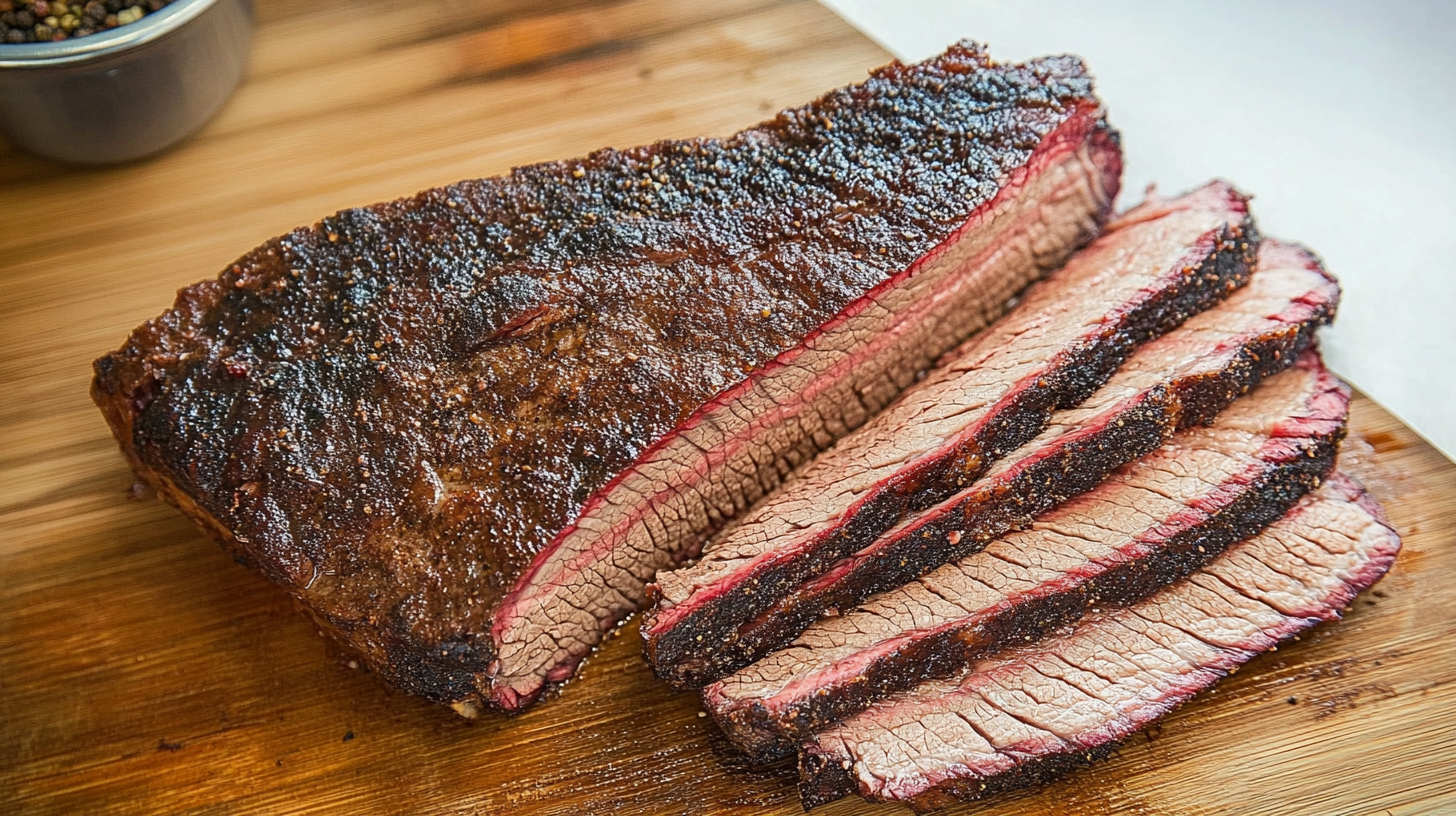Using a beef brisket injection recipe is one of the best ways to keep your brisket moist, enhance its natural flavor, and ensure a juicy, tender bite. Whether you’re smoking, roasting, or slow-cooking, the right beef brisket injection recipe can make all the difference. Unlike traditional marinades, which only penetrate the surface, an injection delivers seasoning and moisture deep into the meat, ensuring every bite is packed with flavor. This technique is especially beneficial for large cuts like brisket, which can sometimes turn out dry if not prepared properly.
In this guide, we’ll cover everything you need to know about using a beef brisket injection recipe, including the best ingredients, step-by-step instructions, and expert tips for achieving restaurant-quality brisket every time.
Table of Contents
What is a Brisket Injection?
A brisket injection is a technique where you use a syringe to inject a liquid seasoning mixture directly into the meat before cooking. The purpose of this process is to:
- Enhance flavor – The injection delivers seasonings, fats, and liquids deep into the meat.
- Retain moisture – Brisket is a tough cut that requires long cooking times. Injecting helps prevent it from drying out.
- Improve tenderness – Certain ingredients, like broth and melted butter, break down connective tissues, making the meat softer.
Unlike brining or marinading, which primarily affect the outer layers, injecting ensures every bite is full of flavor. Many competition pitmasters and barbecue experts swear by this method for achieving juicy, tender, and flavorful brisket.
Key Ingredients for a Perfect Brisket Injection
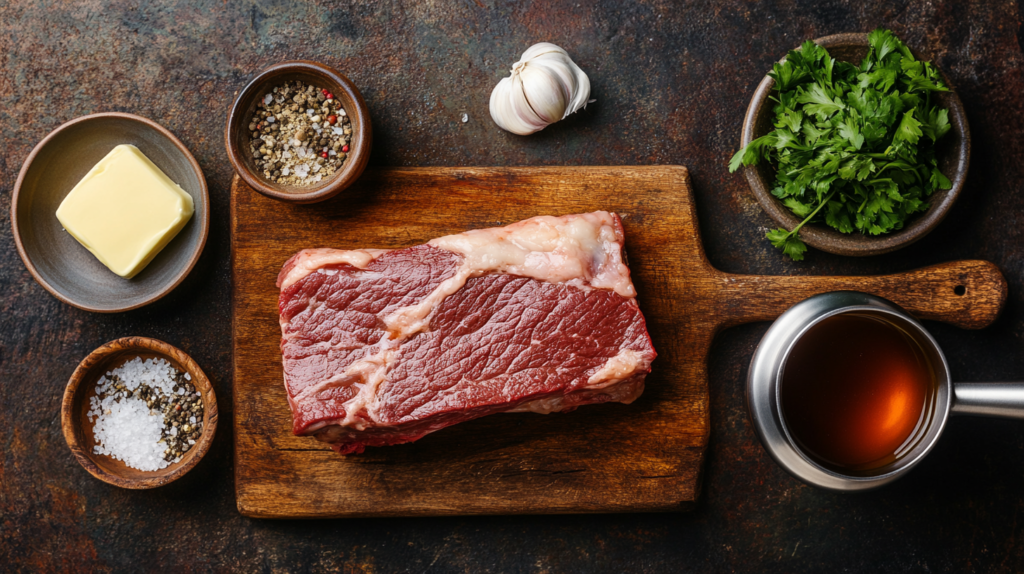
A good beef brisket injection recipe requires a balance of liquids, seasonings, and fats to maximize moisture and flavor. Choosing the right ingredients ensures that your brisket stays juicy, tender, and packed with rich taste throughout the cooking process. Whether you prefer a classic beef brisket injection recipe or want to experiment with different flavors, these essential components will help you achieve the perfect result.
1. Broth & Liquids
The base of any brisket injection is a liquid that can penetrate the meat fibers and distribute flavors. The best options include:
- Beef broth or stock – The most common choice, adding deep, rich flavor.
- Worcestershire sauce – Adds umami and a slight tang.
- Soy sauce – Enhances saltiness and depth.
- Apple cider vinegar – Provides acidity to break down tough fibers.
- Beer or whiskey – Some pitmasters use alcohol to add complexity to the flavor.
2. Seasonings & Flavor Boosters
Seasonings enhance the natural taste of the brisket. The most commonly used include:
- Kosher salt – Essential for bringing out the meat’s flavor.
- Black pepper – Adds mild heat and complements smoky flavors.
- Garlic powder – Provides a subtle savory kick.
- Onion powder – Enhances the depth of the injection mix.
- Paprika – Adds mild smokiness and color.
3. Fats & Tenderizers
Fats help keep the brisket juicy throughout the long cooking process. Popular choices include:
- Melted butter – Adds richness and enhances browning.
- Rendered beef tallow – Provides a meaty depth and mimics the brisket’s natural fat.
- Olive oil – Helps the injection spread more evenly inside the meat.
Using the right combination of these ingredients ensures that your brisket stays moist, tender, and full of bold flavors.
Best Beef Brisket Injection Recipe
Ingredients:
- 2 cups beef broth
- ¼ cup Worcestershire sauce
- 2 tbsp soy sauce
- 2 tbsp unsalted butter (melted)
- 1 tbsp apple cider vinegar
- 1 tbsp kosher salt
- 1 tsp black pepper
- 1 tsp garlic powder
- ½ tsp onion powder
Step-by-Step Guide:
- Prepare the Injection Mix – In a medium bowl, whisk together all ingredients until well combined. Ensure the salt is fully dissolved.
- Strain the Mixture – If using fresh garlic or other solids, strain the mixture to prevent clogging the injector needle.
- Fill the Meat Injector – Use a high-quality injector with a fine needle to evenly distribute the liquid.
- Inject the Brisket – Insert the needle deep into the meat and slowly press the plunger. Repeat across the brisket, spacing injections 1-2 inches apart.
- Let the Brisket Rest – Allow the injected brisket to sit for at least 2-4 hours, or overnight for deeper flavor penetration.
- Cook as Desired – Smoke, roast, or slow-cook the brisket following your preferred method.
This recipe delivers savory, juicy, and perfectly seasoned brisket that melts in your mouth.
Since many brisket injections use beef broth as a base, you might want to explore Delicious Recipes Using Beef Broth to make a rich, homemade version.
How to Inject a Brisket Properly
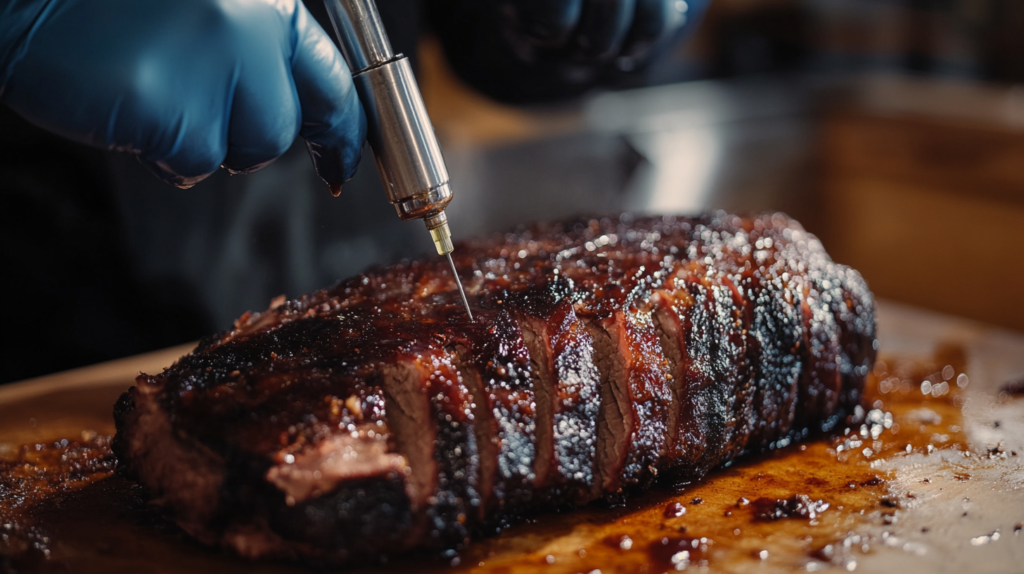
Injecting a brisket the right way ensures that the liquid spreads evenly throughout the meat, enhancing both moisture and flavor. Using a beef brisket injection recipe properly allows the seasoning and juices to penetrate deep into the brisket, preventing dryness and ensuring a tender bite. Follow these steps to inject your brisket like a pro and achieve perfectly juicy, flavorful results every time.
1. Tools You Need
Before getting started, make sure you have the right equipment:
- Meat injector – A stainless steel injector with a fine needle is best.
- Large bowl or measuring cup – To mix and hold the injection liquid.
- Paper towels – For cleaning excess liquid from the brisket.
- Cutting board – A stable surface for working with the brisket.
2. Step-by-Step Injection Technique
Step 1: Prepare the Brisket
- Trim excess fat, leaving about ¼ inch for moisture retention.
- Pat the brisket dry with paper towels to help the injection absorb better.
Step 2: Fill the Injector
- Stir the injection mixture again to ensure the seasonings are evenly distributed.
- Load the injector by pulling back the plunger while the needle is submerged in the liquid.
Step 3: Inject the Brisket
- Insert the needle deep into the meat (not just the fat).
- Inject small amounts of liquid while slowly pulling the needle out to distribute the mixture evenly.
- Repeat this process every 1-2 inches across the entire brisket.
Step 4: Let It Rest
- Once injected, let the brisket sit in the refrigerator for 2-4 hours (or overnight for deeper flavor absorption).
- This allows the liquid to spread through the meat fibers, enhancing both taste and texture.
3. Pro Tips for Injecting Brisket
- Inject against the grain – This helps distribute the liquid more evenly.
- Use a fine needle – A smaller needle prevents large pockets of liquid from forming.
- Inject before seasoning the exterior – This prevents rubs from being washed away.
- Don’t over-inject – Too much liquid can make the brisket mushy.
By following these steps, you’ll ensure your brisket remains moist, flavorful, and competition-worthy.
Once you’ve mastered the injection process, try it in a full recipe like this Green Egg Beef Brisket Recipe for a perfectly smoked brisket.
Brisket Injection vs. Brining: What’s the Difference?
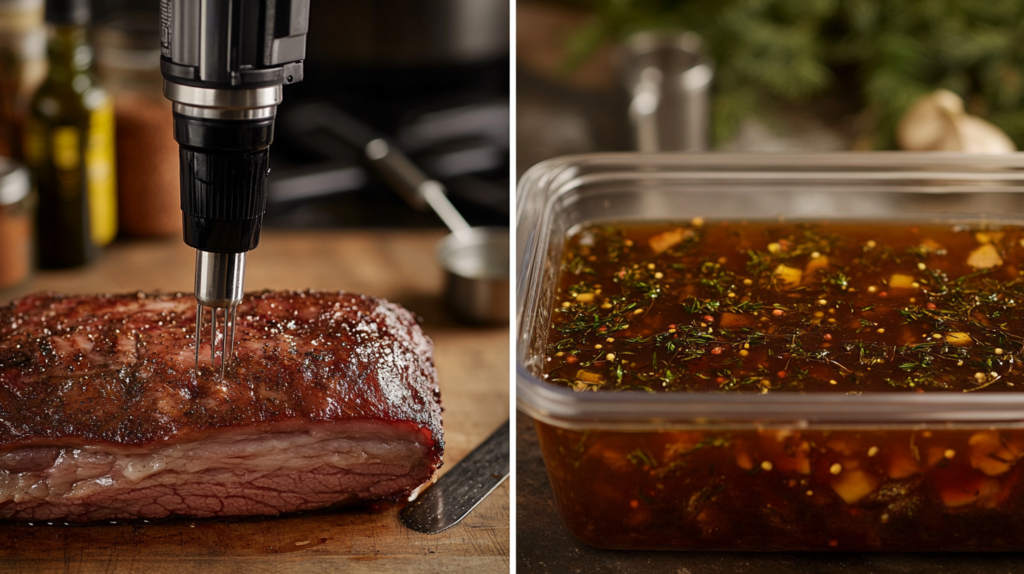
When preparing a brisket, two popular methods for adding moisture and flavor are using a beef brisket injection recipe and brining. While both techniques enhance the meat, they work in different ways and produce distinct results. A beef brisket injection recipe delivers seasoning and moisture deep inside the meat, ensuring a juicy and flavorful brisket, while brining primarily affects the outer layers by slowly infusing the meat with salt and other flavors. Understanding the differences between these methods will help you choose the best approach for your cooking style and desired results..
If you want to learn more about how brining works and how it can complement an injection, check out The Ultimate Guide to Beef Brisket Brine for a detailed breakdown.
1. What is Brining?
Brining is a process where the brisket is soaked in a saltwater solution (often with added seasonings) for several hours or overnight. There are two main types of brining:
- Wet Brining – The brisket is submerged in a liquid solution.
- Dry Brining – The meat is coated with salt and left to absorb moisture from its own juices.
2. What is Injecting?
Injecting involves using a meat injector to distribute a seasoned liquid directly into the muscle fibers. Using a beef brisket injection recipe allows flavors to penetrate deep inside the meat rather than just coating the surface. This technique ensures that every bite is infused with moisture and seasoning, preventing the brisket from drying out during long cooking times. A well-balanced beef brisket injection recipe enhances tenderness, boosts natural beef flavors, and helps create a restaurant-quality brisket with rich, juicy results.
3. Key Differences Between Injecting and Brining
| Feature | Brining | Injecting |
|---|---|---|
| Moisture Retention | Absorbs liquid gradually over time | Directly adds moisture deep into the meat |
| Flavor Penetration | Primarily affects the surface | Reaches deep inside the meat |
| Time Required | 12-24 hours | Immediate results (2-4 hours resting time) |
| Best for | Leaner cuts or poultry | Large, thick cuts like brisket |
| Effect on Texture | Softens the meat slightly | Keeps natural texture intact |
| Salt Content | Can make meat salty if overdone | More controlled salt levels |
4. When to Use Each Method
- Use Brining when you have more time and want a subtle, evenly distributed flavor.
- Use Injecting when you need quicker results and want intense flavor deep inside the meat.
- For the Best of Both Worlds, some pitmasters use both methods—brining for moisture retention and injecting for extra flavor.
If you’re smoking a large brisket, injection is the best choice for ensuring juicy, flavorful meat throughout.
Best Injection Tips for Smoking a Brisket
Injecting your brisket properly is only part of the equation. To get the best results, you need to follow expert smoking techniques along with a beef brisket injection recipe to ensure the meat stays juicy, tender, and packed with flavor. A well-prepared brisket, combined with the right injection and slow smoking process, enhances both texture and taste. By mastering these techniques, you can achieve a perfectly moist and flavorful brisket every time.
1. When to Inject the Brisket
Timing is key when injecting brisket. The best options are:
- 2-4 hours before smoking – This allows the flavors to penetrate the meat without making it mushy.
- Overnight (8-12 hours before cooking) – If using a mild injection, longer marination enhances absorption.
- Right before cooking – This works if you’re short on time, but let the brisket rest for at least 30 minutes before putting it in the smoker.
2. How Long to Let the Brisket Rest After Injection
After injecting, always let the brisket rest in the refrigerator to distribute the liquid evenly. Here’s a general guide:
- Minimum rest time: 2 hours
- Ideal rest time: 4-6 hours
- Maximum rest time: 12 hours (overnight for deeper flavor)
3. Choosing the Best Wood for Smoked Brisket
The type of wood you use can enhance the flavor of your brisket. The best options include:
- Hickory – Classic smoky flavor, slightly sweet.
- Oak – Strong, balanced smoke, great for Texas-style brisket.
- Mesquite – Bold and intense, best in moderation.
- Cherry or Apple – Mild, slightly fruity smoke for a subtle sweetness.
4. Ideal Smoker Temperature and Cooking Time
- Smoking temperature: 225-250°F (107-121°C)
- Estimated cooking time: 1.5 hours per pound
- Internal temperature goal: 195-205°F (90-96°C) for the perfect brisket.
5. Wrapping the Brisket – Yes or No?
- Texas Crutch (Foil Wrapping) – Speeds up cooking and keeps brisket moist.
- Butcher Paper Wrap – Retains bark while locking in moisture.
- No Wrap – Results in a thicker, smokier bark but may take longer to cook.
6. Resting After Cooking
- Let the brisket rest for at least 1 hour after smoking.
- Wrap it in butcher paper or foil and place it in a cooler (without ice) to keep warm.
Following these tips ensures that your injected brisket remains juicy and flavorful throughout the smoking process.
Flavor Variations & Customization
One of the best things about using a beef brisket injection recipe is the ability to customize the flavors to suit your taste. Whether you prefer a sweet, smoky, spicy, or bold brisket, adjusting the injection ingredients can make a huge difference in the final result. A well-crafted beef brisket injection recipe ensures that the meat stays juicy while enhancing its natural richness with complementary seasonings. Here are some of the best flavor variations to try for your next brisket injection.
1. Sweet & Spicy Brisket Injection
This variation adds a touch of heat balanced with a subtle sweetness. Perfect for those who love a little kick in their brisket.
Ingredients:
- 2 cups beef broth
- ¼ cup Worcestershire sauce
- 2 tbsp honey or brown sugar
- 1 tbsp apple cider vinegar
- 1 tbsp hot sauce (Frank’s RedHot or Tabasco)
- 1 tsp cayenne pepper
- 1 tsp black pepper
- ½ tsp garlic powder
Flavor Profile:
✔️ Slight heat from cayenne and hot sauce
✔️ Sweetness from honey or brown sugar
✔️ Tangy depth from apple cider vinegar
2. Smoky & Savory Brisket Injection
Ideal for a deep, wood-smoked flavor with bold umami richness.
Ingredients:
- 2 cups beef broth
- ¼ cup Worcestershire sauce
- 2 tbsp soy sauce
- 1 tbsp smoked paprika
- 1 tsp liquid smoke (optional, for extra smoky depth)
- 1 tsp onion powder
- 1 tsp garlic powder
Flavor Profile:
✔️ Deep, rich umami taste
✔️ Intense smoky notes
✔️ Pairs well with mesquite or hickory wood
3. Bold & Tangy Brisket Injection
This version enhances brisket with sharp, tangy flavors that balance the fattiness of the meat.
Ingredients:
- 2 cups beef broth
- ¼ cup Worcestershire sauce
- ¼ cup apple cider vinegar
- 2 tbsp Dijon mustard
- 1 tbsp lemon juice
- 1 tsp black pepper
- ½ tsp ground mustard powder
Flavor Profile:
✔️ Tangy and zesty
✔️ Perfect for balancing rich, fatty brisket
✔️ Great for pairing with vinegar-based BBQ sauces
4. Garlic Butter Brisket Injection
For those who love a buttery, garlicky brisket with extra tenderness.
Ingredients:
- 2 cups beef broth
- ¼ cup Worcestershire sauce
- 4 tbsp melted butter
- 2 tsp garlic powder
- 1 tsp onion powder
- 1 tsp black pepper
Flavor Profile:
✔️ Buttery and rich
✔️ Strong garlic undertones
✔️ Ideal for those who love a melt-in-your-mouth brisket
5. Texas-Style Bold Brisket Injection
This version is inspired by classic Texas BBQ—simple, bold, and beefy.
Ingredients:
- 2 cups beef broth
- ¼ cup Worcestershire sauce
- 2 tbsp kosher salt
- 1 tbsp black pepper
- 1 tsp garlic powder
- 1 tsp onion powder
Flavor Profile:
✔️ Pure beef flavor with a bold Texas twist
✔️ Simple yet highly effective
✔️ Works well with any smoking method
How to Choose the Right Flavor
- For a mild, crowd-pleasing brisket → Try the Garlic Butter or Smoky & Savory recipes.
- For a bold, Texas-style brisket → Go with the Texas-Style Bold version.
- For a balance of sweet and spicy → The Sweet & Spicy mix is a great choice.
- For a tangy, vinegar-based brisket → Opt for the Bold & Tangy injection.
Customizing your brisket injection allows you to experiment with flavors and create a unique, competition-worthy brisket every time.
If you love injecting brisket for maximum flavor, you might also enjoy this Irresistible Beef Back Ribs Recipe for another delicious BBQ option.
Common Mistakes to Avoid When Injecting Brisket
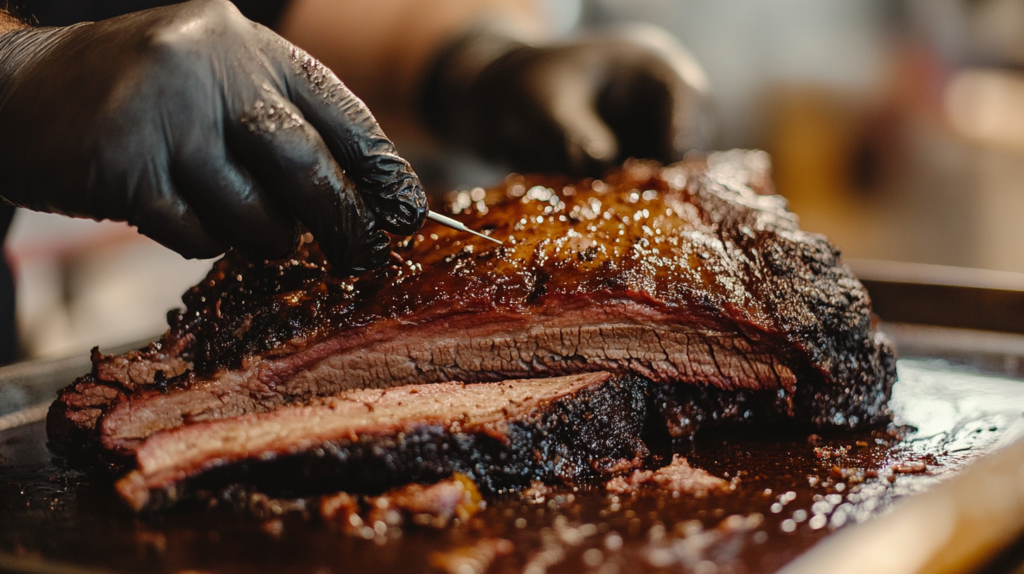
Even though using a beef brisket injection recipe is a simple process, there are a few mistakes that can ruin the texture, taste, or overall quality of your meat. Injecting too much liquid, using the wrong ingredients, or failing to distribute the injection evenly can lead to dry, mushy, or unbalanced flavors. Avoid these common pitfalls to ensure your beef brisket injection recipe delivers a juicy, flavorful, and perfectly cooked brisket every time.
1. Over-Injecting the Brisket
❌ Mistake: Injecting too much liquid can make the meat mushy instead of juicy.
✅ Fix: Stick to 1-2 ounces of injection liquid per pound of meat to maintain the right balance of moisture and texture.
2. Using the Wrong Injector
❌ Mistake: A cheap or low-quality injector can clog easily and make it hard to distribute the liquid properly.
✅ Fix: Use a stainless steel meat injector with multiple needle sizes to handle different types of injection mixtures.
3. Not Straining the Injection Mixture
❌ Mistake: Small particles like garlic, onion powder, or fresh herbs can clog the injector needle and make it difficult to inject evenly.
✅ Fix: Strain the mixture through a fine mesh strainer before loading it into the injector.
4. Injecting Only in One Area
❌ Mistake: If you only inject in a few spots, the liquid won’t distribute evenly, leaving some parts dry.
✅ Fix: Inject the brisket in a grid pattern, spacing injections 1-2 inches apart to ensure even coverage.
5. Injecting Too Shallow
❌ Mistake: If the injection is too close to the surface, the liquid will leak out, wasting the flavor.
✅ Fix: Insert the injector deep into the meat, moving the needle slightly as you inject to spread the liquid evenly.
6. Not Letting the Brisket Rest After Injection
❌ Mistake: Cooking immediately after injecting doesn’t give the liquid time to fully absorb.
✅ Fix: Let the brisket rest for at least 2-4 hours in the refrigerator (overnight for best results).
7. Injecting Too Close to the Fat Cap
❌ Mistake: Fat doesn’t absorb liquid well, so injecting near the fat cap won’t help the flavor penetrate the meat.
✅ Fix: Inject into the muscle, not the fat, to ensure the liquid soaks into the meat fibers.
8. Using the Wrong Ingredients
❌ Mistake: Some liquids, like citrus juice or vinegar-heavy mixtures, can break down the meat too much and affect texture.
✅ Fix: Use beef broth, Worcestershire sauce, soy sauce, or butter-based injections for a balanced, flavorful brisket.
9. Skipping the Test Injection
❌ Mistake: If you don’t taste-test your injection mix first, you might end up with a flavor that’s too strong or weak.
✅ Fix: Always test a small amount by cooking a sample piece of meat or adjusting the mix before injecting the entire brisket.
10. Ignoring the Meat’s Natural Flavor
❌ Mistake: Overloading the brisket with too many flavors can overpower the beefy taste.
✅ Fix: Use a balanced injection mix that complements rather than masks the natural brisket flavor.
Avoiding these mistakes will help you achieve a perfectly injected, juicy, and flavorful brisket every time.
Best Equipment for Injecting Brisket
To inject your brisket properly, you need the right tools. Using high-quality equipment ensures that your beef brisket injection recipe is evenly distributed throughout the meat, leading to a juicier and more flavorful brisket. A reliable meat injector allows the liquid to penetrate deep into the muscle fibers, preventing dryness and enhancing the overall taste. By choosing the right injector and needle type, you can maximize the effectiveness of your beef brisket injection recipe and achieve perfect results every time.
1. Choosing the Best Meat Injector
A good meat injector makes the process easier and more effective. Here are the different types available:
Basic Plastic Injector
- ✅ Affordable and easy to use
- ✅ Works for thin liquids like broth-based injections
- ❌ Can break easily and may not handle thicker injections well
Stainless Steel Injector (Recommended)
- ✅ Durable and long-lasting
- ✅ Comes with multiple needle sizes for different injection types
- ✅ Handles both thin and thick injection liquids
- ❌ Slightly more expensive than plastic options
Commercial-Grade Injector (Competition Style)
- ✅ Holds larger volumes of liquid
- ✅ Often comes with multiple needles for faster injection
- ✅ Best for professional BBQ competitions
- ❌ Bulky and expensive for casual use
2. Best Injector Needles for Brisket
Different needles serve different purposes. Choosing the right one depends on your injection liquid.
| Needle Type | Best For | Pros | Cons |
|---|---|---|---|
| Thin Needle (Single Hole) | Thin, broth-based injections | Prevents clogging, good for smooth liquids | Not ideal for thick sauces |
| Thick Needle (Multiple Holes) | Butter-based or thicker injections | Distributes liquid evenly | May clog if not cleaned properly |
| Wide Needle | Chunky marinades with herbs or spices | Handles thick injections easily | Can leave larger holes in the meat |
Pro Tip: If using a thick injection mix, make sure to strain it well to prevent clogging your injector needle.
3. Alternative Injection Methods (If You Don’t Have an Injector)
If you don’t have a meat injector, here are some workarounds:
- Meat Baster: A turkey baster can work in a pinch, but it won’t inject deep into the meat.
- Flavor Syringe (Large Medical Syringe): A sterilized syringe can work for simple liquid injections.
- Marinating in a Vacuum-Sealed Bag: While not as effective as injecting, vacuum-sealing helps the meat absorb flavors more deeply.
4. How to Clean and Maintain Your Meat Injector
Keeping your injector clean is essential for food safety and longevity.
Steps to Clean Your Injector:
- Disassemble the injector and remove the needle.
- Rinse immediately after use to prevent clogging.
- Run warm, soapy water through the injector several times.
- Use a thin brush (like a pipe cleaner) to remove any residue inside the needle.
- Rinse thoroughly and let it air dry before storing.
A well-maintained meat injector will last for years and consistently help you create juicy, flavorful brisket.
How to Store and Reheat Injected Brisket
Proper storage and reheating techniques are essential to maintain the moisture, flavor, and tenderness of your brisket after using a beef brisket injection recipe. Whether you’re saving leftovers or preparing brisket in advance, following these steps will ensure it stays juicy, delicious, and full of flavor. A well-injected brisket retains moisture longer, but improper storage or reheating can dry it out. By using the right methods, you can preserve the rich taste and tenderness of your beef brisket injection recipe for days after cooking.
1. How to Store Injected Brisket Before Cooking
If you inject your brisket ahead of time, it’s important to store it properly before cooking.
- Refrigeration: Place the injected brisket in an airtight container or wrap it tightly in plastic wrap. Store it in the coldest part of the refrigerator for up to 12 hours before cooking.
- Vacuum Sealing: If you’re prepping more than 12 hours in advance, vacuum-seal the brisket to prevent oxidation and flavor loss.
- Avoid Freezing Injected Brisket (Before Cooking): Freezing can cause the injected liquid to expand and change the texture of the meat.
2. Storing Cooked Brisket Properly
If you have leftover brisket, proper storage keeps it fresh for days.
| Storage Method | How Long It Lasts | Best Practices |
|---|---|---|
| Refrigerator (Whole Brisket) | 4-5 days | Wrap in butcher paper or foil, then place in an airtight container. |
| Refrigerator (Sliced Brisket) | 3-4 days | Store in an airtight container with a little beef broth to retain moisture. |
| Freezer (Whole or Sliced) | Up to 3 months | Wrap in plastic wrap, then heavy-duty foil, and store in a freezer bag. |
Pro Tip: If freezing, label the package with the date and type of injection to keep track of freshness.
3. Best Methods to Reheat Injected Brisket
Brisket can dry out quickly when reheated. Use these methods to retain its moisture and tenderness.
Oven Method (Best for Whole Brisket or Large Pieces)
- Preheat oven to 225°F (107°C).
- Wrap the brisket in foil with a little beef broth or butter inside to keep it moist.
- Place the wrapped brisket on a baking sheet and heat for 45-60 minutes (or until it reaches 165°F (74°C) internally).
- Let it rest for 10 minutes before slicing.
Sous Vide Method (Best for Maximum Juiciness)
- Set the sous vide to 165°F (74°C).
- Place the vacuum-sealed brisket in the water bath.
- Heat for 1-2 hours, depending on the brisket size.
- Remove, unwrap, and let it rest before slicing.
Smoker or Grill Method (Best for Maintaining Bark and Smoke Flavor)
- Set the smoker or grill to 225°F (107°C).
- Wrap the brisket in foil or butcher paper with a small amount of beef broth.
- Place it back in the smoker and heat for 30-45 minutes.
- Remove and let it rest before serving.
Microwave Method (Only for Small Portions)
- Place sliced brisket in a microwave-safe dish with a few tablespoons of beef broth.
- Cover loosely with a damp paper towel to prevent drying out.
- Heat on medium power in 30-second intervals, flipping slices as needed.
- Serve immediately.
4. Keeping Reheated Brisket Moist
- Always reheat slowly at a low temperature to avoid drying out.
- Add a little beef broth, butter, or BBQ sauce before reheating to retain juiciness.
- Don’t slice until ready to serve—keeping it whole preserves moisture.
By following these storage and reheating methods, your brisket will stay tender, juicy, and full of flavor even days after cooking.
Pairing Brisket with Sides and Sauces
A perfectly prepared brisket using a beef brisket injection recipe deserves delicious side dishes and sauces that enhance its flavor. Whether you prefer classic BBQ pairings or unique twists, the right accompaniments can elevate your brisket experience and complement the rich, smoky taste. A well-balanced beef brisket injection recipe ensures a juicy and flavorful brisket, but pairing it with the perfect sides and sauces takes your meal to the next level.
1. Best Side Dishes for Brisket
Brisket is rich and flavorful, so it pairs best with sides that complement its smokiness and texture.
Classic BBQ Sides
These traditional side dishes are always a hit at a brisket feast.
- Mac and Cheese – Creamy, cheesy goodness that balances the smoky brisket.
- Coleslaw – A fresh, tangy crunch that cuts through the richness.
- Baked Beans – Sweet and smoky beans add depth to every bite.
- Cornbread – Slightly sweet and buttery, perfect for soaking up brisket juices.
- Potato Salad – A cool, creamy contrast to the warm, smoky meat.
Southern Comfort Sides
Want to add a down-home feel to your brisket meal? Try these Southern-inspired favorites:
- Collard Greens – Savory, slow-cooked greens with smoky bacon.
- Grits – A smooth, buttery side that pairs well with BBQ flavors.
- Hush Puppies – Fried cornmeal balls that add crunch and sweetness.
Lighter & Healthier Side Options
For a balanced meal, pair brisket with lighter, veggie-based sides.
- Grilled Vegetables – Asparagus, zucchini, or bell peppers add a fresh contrast.
- Cucumber & Tomato Salad – Refreshing and tangy to cleanse the palate.
- Roasted Brussels Sprouts – A crispy, slightly sweet alternative to heavier sides.
2. Best Sauces for Brisket
While a well-cooked brisket is delicious on its own, the right sauce can enhance its flavor.
Classic BBQ Sauces
- Texas-Style BBQ Sauce – A spicy, tomato-based sauce with a bold kick.
- Kansas City BBQ Sauce – A sweet and smoky sauce made with molasses and brown sugar.
- Carolina Mustard Sauce – A tangy mustard and vinegar-based sauce with a little spice.
Unique Sauces to Try
- Bourbon BBQ Sauce – A rich, smoky sauce with a hint of sweetness from bourbon.
- Coffee-Based BBQ Sauce – Adds a deep, roasted flavor that complements smoked brisket.
- Honey Chipotle Sauce – A mix of sweet and spicy for those who like bold flavors.
3. Best Breads for Serving Brisket
Brisket can also be served as a sandwich, taco, or platter. The best breads for brisket include:
- Brioche Buns – Soft, buttery, and slightly sweet.
- Texas Toast – Thick, buttery slices of toasted bread.
- Corn Tortillas – Great for brisket tacos with fresh toppings.
4. Best Drinks to Pair with Brisket
Pair your meal with drinks that enhance the smokiness of the meat:
- Beer: A dark stout or hoppy IPA balances brisket’s richness.
- Whiskey: A smoky bourbon complements BBQ flavors.
- Iced Tea or Lemonade: Classic Southern drinks to refresh the palate.
5. Putting It All Together – The Ultimate Brisket Feast
For the best meal experience, serve your brisket with:
✔️ Mac and Cheese or Baked Beans
✔️ Coleslaw for a refreshing crunch
✔️ Texas BBQ Sauce or Bourbon Glaze
✔️ Brioche Buns for a sandwich option
✔️ Cold Beer or Sweet Tea to complete the meal
With these sides and sauces, your brisket dinner will be unforgettable!
FAQs on Brisket Injection
Here are some of the most common questions about using a beef brisket injection recipe, along with expert answers to help you achieve the best results. Whether you’re wondering about the best injection ingredients, techniques, or timing, understanding these key details will ensure your brisket stays juicy, flavorful, and perfectly cooked.
1. Can I inject brisket the night before?
✅ Yes. Injecting brisket 12-24 hours before cooking allows the flavors to fully absorb into the meat. Just make sure to refrigerate it after injection and let it rest before smoking.
2. What is the best liquid for brisket injection?
The best liquid depends on the flavor profile you want. Popular choices include:
- Beef broth – Adds rich, meaty depth.
- Worcestershire sauce – Enhances umami flavor.
- Melted butter – Helps with moisture retention.
- Apple cider vinegar – Adds a slight tang and tenderizes the meat.
3. Should I inject the brisket before or after seasoning?
✅ Inject first, then apply the dry rub. This prevents the seasoning from being washed away during the injection process.
4. How much injection liquid should I use?
Use about 1-2 ounces of injection liquid per pound of meat. Over-injecting can cause the brisket to become mushy.
5. Where should I inject the brisket?
Insert the needle into the muscle (not the fat) and inject every 1-2 inches in a grid pattern to ensure even flavor distribution.
6. Can I use a marinade instead of an injection?
✅ Yes, but it won’t penetrate as deeply. Marinades only coat the surface, while injections deliver flavor inside the meat.
7. Will injecting change the texture of the brisket?
✅ No, if done correctly. Use the right amount of liquid and avoid over-injecting to maintain the meat’s natural texture.
8. What happens if I inject too much?
Over-injecting can make the brisket too wet and soft, leading to an unnatural texture. Stick to the recommended 1-2 ounces per pound.
9. Can I freeze an injected brisket?
🚫 Not recommended. Freezing an injected brisket before cooking can affect the texture and cause liquid expansion, which may lead to uneven moisture distribution.
10. Do competition pitmasters inject brisket?
✅ Yes! Many BBQ competition pros inject their brisket to ensure maximum moisture and flavor during long smoking sessions.
Conclusion
Using a beef brisket injection recipe is one of the best techniques for keeping your brisket juicy, flavorful, and competition-worthy. By selecting the right ingredients, injecting evenly, and following proper storage and cooking methods, you can achieve restaurant-quality brisket every time. Whether you prefer a savory, smoky, or spicy injection, experimenting with different flavors will help you discover the perfect blend for your BBQ style.
Next time you fire up the smoker, use a beef brisket injection recipe to take your brisket to the next level of tenderness and taste.

